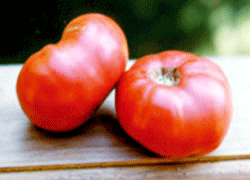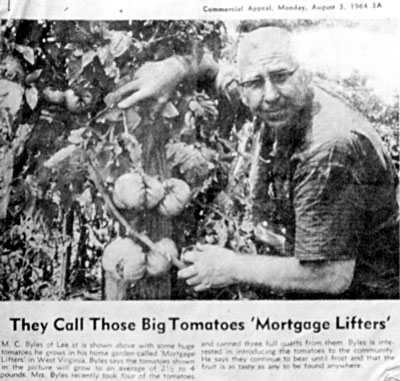Mortgage Lifter Tomatoes
Air Date: Week of September 23, 2005

Photo courtesy of Jeff McCormack
Living on Earth's Jeff Young learns the history of one of his favorite tomatoes: Radiator Charlie's Mortgage Lifter. The man who developed it had a life as colorful as the plant that bears his name.
Transcript
GELLERMAN: These days at harvest festivals and county fairs you can find green thumb growers showing off the fruits of their labors--local produce grown with care and pride…and can anything be more worthy of a boast than a delectable tomato, ripening on the vine right in your own backyard? Especially those heirloom varieties, the ones with odd shapes, colors and names to match. There are the Tommy Toes, tiny as grapes, Brandywines, deep red as a glass of cabernet, and Banana Legs, yellow and yummy. Living on Earth’s Jeff Young was curious about one of his favorites, a tomato with an especially peculiar name, and he discovered a story behind it as colorful as the fruit itself.
YOUNG: Where I grew up in West Virginia, old timers called them “Mortgage Lifters.” They’re tasty without being acidic, and the flattened, pinkish fruits get big. Really big—I’m talkin’ a pound or two apiece. The best of them carried a longer name: “Radiator Charlie’s Mortgage Lifter Tomato.” I often wondered about that name. So did Jeff McCormack.
YOUNG: Mccormack runs a seed catalog company from his home in Charlottesvile, Virginia. He specializes in rare lines of heirloom plants and seeds passed down through families and friends.
MCCORMACK: But, you know, when it’s being passed down in a family for 200 years there must be something good about it.
YOUNG: In the mid 80s, McCormack got his hands on some tomato seeds and a heck of a story. It came in the form of a scratchy old tape recording of a conversation between Ed Martin of Virginia, and his grandfather, the originator of the Mortgage Lifter Tomato.
MARTIN: I am sitting at 860 Lee St talking to my grandfather MC Byles and he’d get mad if anybody said it is Marshall Cletis Byles.
YOUNG: Marshall Cletis Byles preferred to go by MC or just Charlie. The tape is tough to hear—cars, trains and, at one point, an ice cream truck interfere. But it rewards the careful listener. Martin tries to keep his grandad on topic—he wants to know the origin of the Mortgage Lifter Tomato.
MARTIN: That’s a heck of a tomato. Look, didn’t you tell me there were five tomatoes that made that thing?
YOUNG: Byles talks about the tomato all right, but not right away. He wanders in his recollection, as 85-year-olds are wont to do. He talks about cars he’s owned, jobs he’s worked, places he’s lived—and what emerges is the story of a truly remarkable life. The grandson asks how Charlie got started with gardening. Byles tells him it was when his mother sent him to work in the cotton fields of North Carolina. He was four years old. BYLES: Mother said “come out from under there.” I said “what do you want?” She said, “you’re going to work.” “I’m too little to work.” “No, you are not.” I had to go out there and start pickin’ cotton. YOUNG: As a young man in the National Guard, Byles took up wrestling and got so good he went on a wrestling tour of towns in Appalachia where it’s called “wrasslin.’ The pay was a dollar for every minute he lasted in the ring. BYLES: What you did, if he didn’t throw you in 10 minutes, you’d get a dollar a minute. I never lost, but very few times. YOUNG: Byles learned to pilot small planes and flew airmail routes. He loved fixing planes and inventing things. He once came up with a new kind of garden tiller, but didn’t think to get a patent. He found business success as an auto mechanic in the rugged hills of Logan, West Virginia, where heavy coal and timber trucks constantly blew out radiators grinding up the steep grades. McCORMACK: And I think that’s where he acquired his name “Radiator Charlie.” YOUNG: That’s seed saver Jeff McCormack. McCORMACK: Incidentally, the shop was located at the foot of a large mountain where the trucks had to roll back down the mountain to his shop after the radiator blew. YOUNG: Location, location, location. He sounds like the classic American tinkerer. McCORMACK: Exactly. And the beauty of it is that he did this all without formal education. BYLES: Well, I’ve always had a mind of doing things that nobody else couldn’t do. I never been to school a day in my life but anything I wanted to do, I done it. YOUNG: Sometime in the early 40s, Radiator Charlie Byles wanted to build a better tomato. You remember this is a story about a tomato, right? Well, this is how he did it. BYLES: What I did I took ten plants and put them in a circle and put one in the center. YOUNG: McCormack has studied this part of the tape carefully and says Byles invented an unorthodox but elegant system. McCORMACK: Well, he started with four varieties of tomatoes and he placed a tomato called German Johnson in the center of a ring of 10 tomatoes. All these tomatoes were the largest seeds he could find in the country at the time. So, he would go around to the other tomatoes, collect pollen in the baby’s ear syringe, then squirt it on the flowers of the German Johnson. Then he would save seed. After seven years, he felt he had a stable tomato with all qualities he was looking for, and once he was satisfied with that he never worked with any other tomato plants, did any other plant breeding. But he really ran with it after he developed it. YOUNG: Ran all the way to the bank. Turns out Radiator Charlie Byles had quite a knack for marketing, and sold tomato seedlings for a buck apiece—a lot of money for a little plant in those days. He sold enough of them to pay off the mortgage on his house. BYLES: I didn’t pay but six thousand dollars for my home, and paid most of it off with tomato plants. YOUNG: So, there you have it: Radiator Charlie’s Mortgage Lifter Tomato. McCormack says the story is more than just a good yarn. When he put it in the seed catalog it attracted curious gardeners who grew the tomato, saved the seed, and, perhaps unwittingly, helped keep the strain alive – a small victory for preserving genetic diversity at a time when most agriculture is heading toward a homogenized industrial scale. And McCormack finds something else of value in these seed stories, something a little harder to pin down. MCCORMACK: What I’m trying to do is also sort of save the soul behind these seeds, the thin line that extends from one generation to another. And each, the people are connected with the seeds, culture and agriculture are inexorably intertwined. They’re like two sides of the same coin. YOUNG: MC "Radiator Charlie" Byles died at the ripe old age of 97. At the time of his talk with his grandson, he had already outlived many of his friends and family. He wondered aloud why he had lived so long. BYLES: The Lord left me here all these years for some purpose. I don’t know what it is. MARTIN: Maybe it was that tomato. (LAUGHTER) YOUNG: Maybe it was that tomato. And maybe that’s not so bad. For Living on Earth, I’m Jeff Young in Charlottesville, VA. [MUSIC: Guy Clark “Home Grown Tomato” from ‘Keepers’ (Sugar Hill Records – 1997] GELLERMAN: To see pictures of Radiator Charlie and his Mortgage Lifter Tomato and to learn more about heirloom seeds visit our web site Living on Earth dot org. That's Living on Earth dot o-r-g. [MUSIC: Guy Clark “Home Grown Tomato” from ‘Keepers’ (Sugar Hill Records – 1997] When I die don't bury me Links
|






